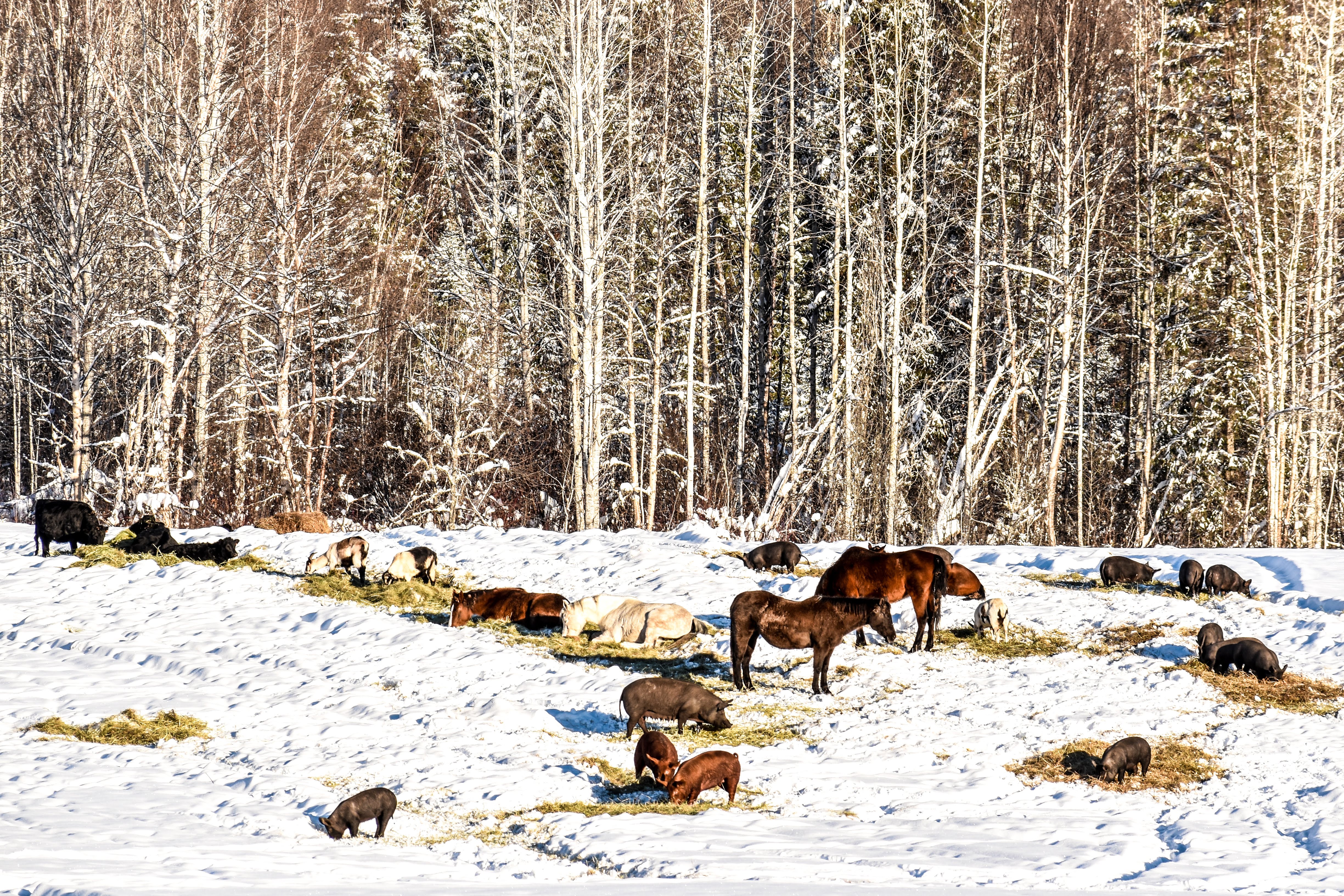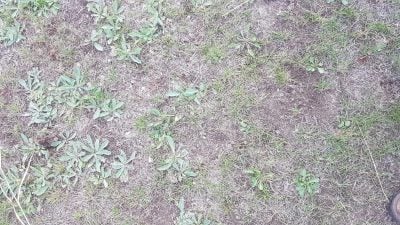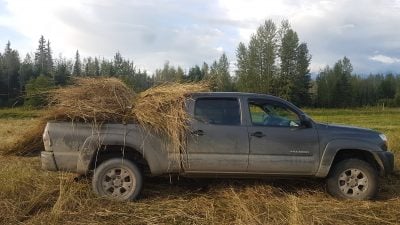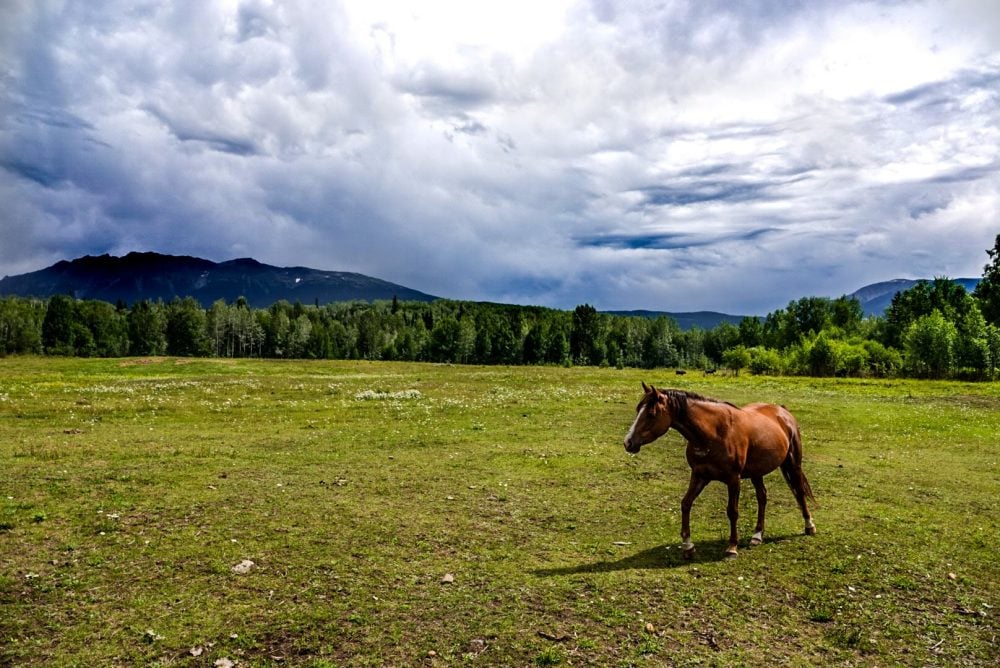
I am an absolute rookie when it comes to pasture and grass management. For years I couldn’t really conceive of it; I guess I took grass for granted. Being the ongoing steward of a small piece of the earth has changed that, and over the last three years since moving to our land, I’ve started to understand the concepts of rotational grazing and resting parts of the pasture. In the time that I’ve come here, I’ve become fascinated with regenerative agriculture concepts – that is to say, the idea that we can work with the land for both its optimum health and ours, and that of our domestic and wild non-human friends.
Regenerative agriculture (RA) is an entire movement – complete with theory, dogma, prophets, and heated internet arguments – that, ultimately, aims to increase biodiversity, decrease heavy land management (like tilling), and sequester carbon rapidly through health root growth and retention. There are a lot more talking points on RA, and seemingly endless approaches and goals therein, and I am really just beginning to scratch the surface in my own research and the experiments we do on the farm. It is generally spoken about in terms of animal or mixed agriculture, but there is no reason why those of us keeping horses shouldn’t use the same principles. Suffice to say, I think you’ll be seeing more content from both Jini and I (and hopefully some guests!) in the near and far future as we dive into what it means to holistically manage our equine herds as part of a thriving ecosystem.
Last winter, with the addition of a small herd of cows, our one round-bale horse feeder was no longer sufficient. With the two (actually four, with pigs and goats) species constantly at odds around resources, I knew the horses might well just guard the hay and not allow the cows – several of them pregnant – to eat enough. Our hay guy suggested rolling the bales out across the pasture to give more access to each bale, and then promptly set about doing this for us, driving single bales out twice a week and rolling them out himself before I could pull on my boots and stumble through the snow to help him. We don’t have our own tractor and we don’t have storage for all the round bales we need, so we usually default to what we’re able to do, or what the hay man is willing to help us with – which is quite a bit, but we are acutely aware of the limits of human capabilities and willingness, even if he isn’t!

At first we were shocked at the waste the animals left behind, pooping directly in the hay and leaving apparently good food to come beg at the fence until we relented and ordered another bale. When you have as many moving parts as we do, most systems end up being “good enough” and left that way even when they aren’t ideal. There’s not a lot of time to go back over everything and tweak it all to perfection; that seems to happen gradually, a little here and a little there, and everything always in process. So we rolled our eyes at the waste and mess and kept doing the same thing because we didn’t have a better option.

Come spring, there was a heavy mulch of poo and hay wherever the bales had been rolled out – most specifically, on the slight hill where rolling had been easiest for our hay man. Today in late summer, that hillside is still the greenest and most lush area in our pasture.

This year has been tough for growing. We went into winter after a long, hot summer that left us in severe drought, which we didn’t really acknowledge when everything was frozen over and snow was on the ground. In fact, we did not get the “usual” amount of snow, and the ground itself had very little moisture retained within it. So when the thaw came, there was hardly anything to kick start the grass growth. As a result, the short-lived grass, targeted by the animals, gave way quickly to weeds like hawkweed, daisy and buttercup, leaving very little food for our grazers and foragers. But all on that hillside, the grass stayed green and lush. A little research illuminated why:
1. Mulch. Mulch is a wonderful retainer of moisture. The wasted hay stalks had covered the damaged soil and kept it from drying out early on.
2. Seed. Hay is full of grass seed. All the uneaten seeds had fallen through the stalks and planted themselves in the moist environment.
3. Fertilizer. Horses and cows poo where they eat! So by unwittingly concentrating their eating area to this hillside, we had also concentrated their manure distribution. We get a hard freeze in the winter for at least a week at a time, which I understand kills the worm load in the manure – we can leave it in the field and not compost it first.
4. Organic material. While grazing removes organic material, hay waste (and poo) actually add it. This area will continue to break down and regenerate as the dead grass returns to the earth.
This hill had been mulched, seeded and fertilized without us lifting a finger.

The hay is quite mature and not particularly tasty, so the horses are wasting lots of it (great!). But it’s enough to attract them to nibble, and therefore poo as well. We won’t know til next year if this treatment does anything noticeable, but we now know there is nothing wrong with adding clean organic material to our fields.
This winter, I’ll show you my plan for utilizing this mulch/poo discovery a little more methodically. Til then, I’m crossing my fingers we have another month of green grass left!
I’d love to hear from you in the comments below how (or if) you’re managing pasture. What’s working? What isn’t? And if you have any questions, let’s hear them too!
More articles related to pasture management:
How to Use Goats for Pasture Management
How to Get Your Pastures to Grow Faster & Reduce Sugar!
Get Rid of Pervasive Weeds by Strengthening Pasture Grasses
A barefoot hoof trimmer, a singer/songwriter, an amateur farmer – these are some of the hats Kesia Nagata wears when she’s not full to bursting with wondrous equine co-creation.










I loved seeing this post. I work for a non-profit out of New Mexico called the Quivira Coalition. We support regenerative ranching and farming throughout the arid West. I have two horses and I’ve been trying to apply what I learn at work to how I manage the land we live on. It’s so interesting and challenging because like horses, you have have to deeply listen and not just follow what is in a book. My strategy so far has been to let them have one main area that is more degraded but I move them around the property with electric fence to let them have grazing time and to help manage the health of the grasses. It’s my first season and it has definitely raised more questions than answers! Love the idea of mulching. Please keep posting about this. I think it’s important and helpful to talk about how we can support the land we live on with horses. Thank you!!
Oh my GOSH, Lynne, how cool! I just looked up your org – by day I work for Skeena Watershed Conservation Coalition, which began with a focus on salmon and watershed health but kinda grew in lots of organic directions over the years; just this year we are launching a regenerative agriculture program. Baby steps but so exciting! I will look at your website more and hopefully draw some inspiration.
Very much yes to listening: as I research, I still get frustrated by colonial, top-down approaches to permaculture and regeneration. Listening is key – and I am grateful for the time, space and freedom to learn to land-listen.
More questions than answers is usually how I roll too, haha. This is also our first year seriously considering how the horses impact the land, and how we might manage that to both their best interests.
We will definitely keep posting, it’s fascinating and exciting and very, very hopeful stuff.
Would love to hear more about your work with Quivira Coalition 🙂
That’s cool you are working in the non-profit world too! I’m so excited to hear what you come up with for horses and land management.
For Quivira, we have a big annual conference that we do with Holistic Management International and the American Grassfed Association. There lots of interesting speakers and it live-streams for free. It’s November 19-22. Past conference talks are on our you tube page. One of my other favorite resources is the online magazine On Pasture if you haven’t already heard of it.
There is definitely a lot less information about horse related land management. Maybe we can both add to what is out there…!
Ooh, looking forward to checking it all out! I love getting interested in something and then discovering that there is a whole world of info just waiting to be slurped up.
And yes, let’s add to the horse-keepers’ regenerative land management literature! I suppose the main differences are that we’re not thinking about profit (from meat) – though we should think about saving feed money – and we generally run horses in much smaller herds than livestock are managed in. So right there are two distinctions that might make for different approaches. Also, I believe in Europe folks have been managing small plots of grazing for a very long time, so there is likely more information in that direction.
Looking forward to nerding and collaborating with you and everyone else!
I know I am a bit late to this post! But I just watched a movie titled “The biggest little farm” It was about a couple in southern Calif that started a farm and hired a regenerative consultant who said by the 7th year the farm would balance out with nature and become in flow! It was a cool movie and I love how Mother Nature has a balance for everything and humans could actually be a part of that and even give little nudges in that direction to help! Like providing owl boxes and Guardian live stock dogs…and putting ducks in orchards to devour thousands of snails! It was truly a beautiful example of working with the earth instead of against her! I highly recommend the movie! Here in our nook of California it is so dry for about 4-5 months we don’t get any rain and that is the normal for our time and place! So rotational grazing is not really applicable? When it’s gone it’s gone? But I have tried to keep improving there movement so the horses are not over punishing what we do inhabit! I am a daily poo picker so the land does not get to enjoy the natural fertilizer it should…as Bullet is a high worm burden guy (he came that way) and it’s important for me to try and keep his exposure to a minimum! I do however fertilize the garden and different parts of the land with the poo…and then feed the horses fresh veggies from the garden so at least there is some regeneration! At some point I want to expand our manjeri of animals and really diversify to help the land…but life has had another plan for my time as of late and it’s just not happening right now! I hope our LTYH family chimes in and you ladies keep spreading the love knowledge to help us all help do a minute part in keeping Mother Earth as healthy as possible and hopefully healing her scars and abuse we continue to add! ✌🏼❤️🐴🌎
Michelle – even though I’m in Europe right now, you and I are obviously still in sync because I too just watched The Biggest Little Farm and came here to post about it!! So yes, Kesia and everyone should watch this movie – it is not only well done as a film, but the information is SO interesting. The interplay between “weeds” “predators” “pests” and what the humans were wanting was just so cool.
I would like to know if anyone here knows WHY whatever animal killed dozens of chickens, does that?? Why not just kill/eat what they need? In the movie they put this down to coyotes, but I’ve heard foxes do the same thing – and when he set up those night cams, we saw raccoons, possums and I believe I glimpsed a cougar too. Is it because the chickens are confined and this sets up a frenzy-driven ruckus? Or do the chickens fight back? Would love to hear from anyone who has any more information/experience of this…
We are in sync…😛…As I was thinking the same thing about the extreme unnecessary killing of the chickens and ducks! I think when you get a predator that has such an easy time killing it probably is just exciting for them to make kill after kill even though they can’t eat them all…kind of scary…that animals can behave like us when we set up certain scenarios😢…obviously in the wild they would not have such easy access to such huge numbers of such easy to kill prey! The movie was so inspiring I have been so excited that just my one owl box has created such a drastic decrease in mice and moles/voles/gophers …and also now that we are nurturing the land with more water… an increase in snakes…to help out! I am also experiencing somewhat of the same situation to them as each year we live here presents a different out of control species! This year has been ground squirrels! Our family dogs both died last year and I have been waiting to rescue new dogs as I am helping out my son with his new puppy and his old dog who does not do well with others! The lack of foxes, coyotes, bobcats, and consistent domestic dogs has the squirrels way out of balance! The hawks try and we even watched a sand hill crane kill a baby squirrel but they are such hard critters to get…that there population exploded! We have had to result to traps ..(I will not use poison) .as they are infested with fleas and digging holes everywhere! Hoping to bring some new dogs into the mix by next year to help keep them in check? They are also wreaking havoc on the garden! But like I said they are almost impossible to catch! It is a hard balance to be at one with Mother Nature…and still live our domestic lives! I do my best to live in harmony as much as possible and to find natural solutions to invasive species…but sometimes I do resort to killing in order to keep critters in check! ✌🏼❤️🐴
Chickens are easy to kill but very heavy. Ravens here will pop the heads off a bunch at a time but can’t fly away with them…they also teach their grown babies how to kill on our birds. Mink will drink the blood and leave the body… and yeah some animals might just go into frenzy mode! Especially dogs. Haha…flyby notes on chicken death…
WHO KNEW??? Seriously. All this stuff that you can’t possibly know in advance. And nature offering up endless variations on the theme depending on the certain mix of mitigating factors… it’s enough to make you just throw up your hands.
So then the next thought that comes to mind is… how did chickens survive in the wild before humans? They seem like such an ideal food source for SO many… how did they live/breed/multiply?
Michelle – I googled it and hawks, eagles and owls all eat squirrels, so perhaps a couple more owl boxes?? Seems they would also control snakes, groundhogs, rats, etc. Since you don’t have CHICKENS (!!) it would seem to be ideal…?
Same way grouse are still around. They are prolific! And good mamas. No but actually, chickens are jungle fowl and would live under thick tree/bush canopies, and be smaller, faster, and more camoflauged, adapted to their environment…they would not be confined or living in such big delicious numbers, and they would sleep up high in trees during the night. It’s just our fault like everything else, that’s all.
PS I have since watched this movie and have NO IDEA why so many chickens were killed without being hauled away and eaten…I’ve never seen this or heard of it except for with dogs losing their minds. We have chickens vanish or we find them when the killer has been thwarted or interrupted… but you can always figure out a reason… so strange!
That’s what I thought! That’s why I’m not convinced it’s a coyote either… When they set up the video cam, it sure showed a whole variety of chicken killers – raccoons, possums, cougar, coyote – so how could they just assume coyote? And for it to happen repeatedly… something weird going on. Maybe too many chickens for the size of enclosure? Maybe once predator got in, it couldn’t get out = panic? Maybe the chickens attacked the predator? Sure would like to know…
And regarding your other comment, so chickens originally would be better at flying – we have bred them to be breast-heavy and unevenly weighted, no doubt.